Policy Implementation in Human Resource Management: An Analysis
VerifiedAdded on 2023/03/23
|10
|2700
|89
Essay
AI Summary
This essay delves into the complexities of policy implementation within the realm of Human Resource Management (HRM), particularly focusing on how domestic policies are applied and adapted in offshore environments. The paper examines three key policy areas: performance management, hiring practices, and compensation strategies. It explores the impact of globalization, environmental influences, and cultural differences on these policies. The essay highlights the need for dynamic and robust HRM approaches to achieve organizational goals in diverse international contexts, considering factors such as differing labor laws, cultural values, and skill levels. The analysis covers how companies must adjust their strategies in areas like performance appraisals, recruitment, and remuneration to align with local regulations and cultural norms. It also discusses how compensation policies are influenced by taxation, cost of living, and inflation, emphasizing the importance of flexibility in HRM to manage subsidiaries effectively across different countries. This essay provides a comprehensive understanding of the challenges and strategies involved in implementing HRM policies on a global scale.
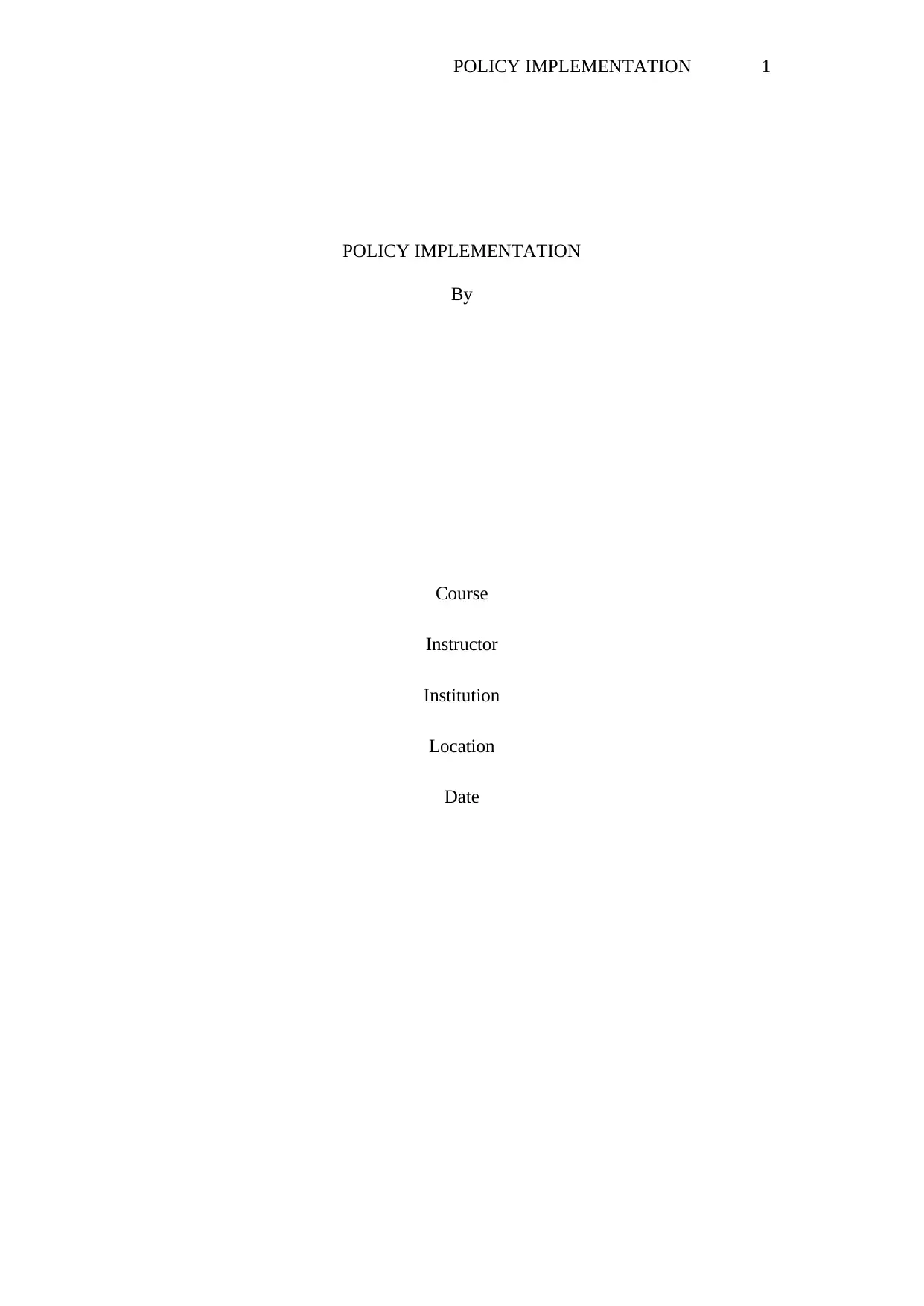
POLICY IMPLEMENTATION 1
POLICY IMPLEMENTATION
By
Course
Instructor
Institution
Location
Date
POLICY IMPLEMENTATION
By
Course
Instructor
Institution
Location
Date
Paraphrase This Document
Need a fresh take? Get an instant paraphrase of this document with our AI Paraphraser
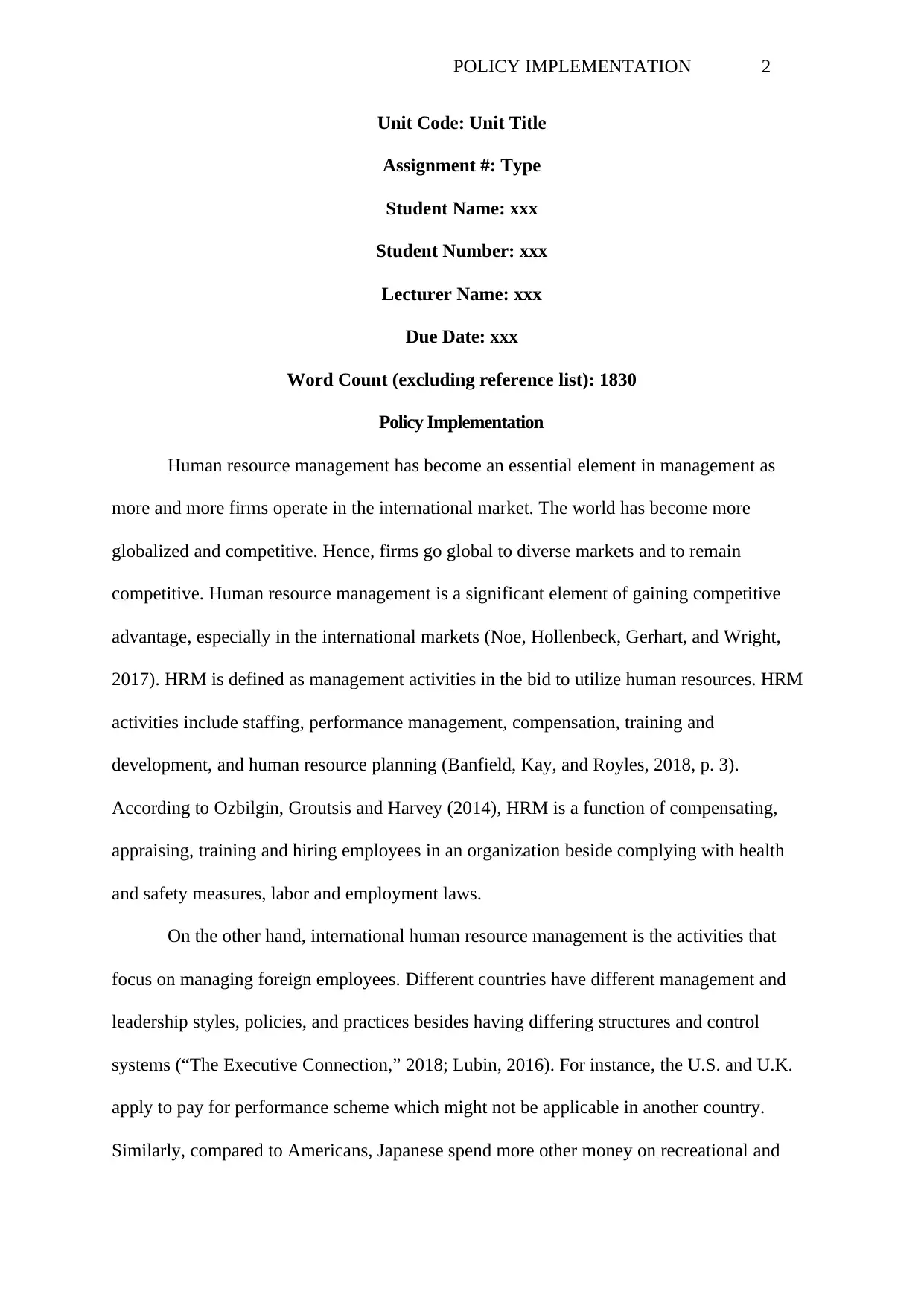
POLICY IMPLEMENTATION 2
Unit Code: Unit Title
Assignment #: Type
Student Name: xxx
Student Number: xxx
Lecturer Name: xxx
Due Date: xxx
Word Count (excluding reference list): 1830
Policy Implementation
Human resource management has become an essential element in management as
more and more firms operate in the international market. The world has become more
globalized and competitive. Hence, firms go global to diverse markets and to remain
competitive. Human resource management is a significant element of gaining competitive
advantage, especially in the international markets (Noe, Hollenbeck, Gerhart, and Wright,
2017). HRM is defined as management activities in the bid to utilize human resources. HRM
activities include staffing, performance management, compensation, training and
development, and human resource planning (Banfield, Kay, and Royles, 2018, p. 3).
According to Ozbilgin, Groutsis and Harvey (2014), HRM is a function of compensating,
appraising, training and hiring employees in an organization beside complying with health
and safety measures, labor and employment laws.
On the other hand, international human resource management is the activities that
focus on managing foreign employees. Different countries have different management and
leadership styles, policies, and practices besides having differing structures and control
systems (“The Executive Connection,” 2018; Lubin, 2016). For instance, the U.S. and U.K.
apply to pay for performance scheme which might not be applicable in another country.
Similarly, compared to Americans, Japanese spend more other money on recreational and
Unit Code: Unit Title
Assignment #: Type
Student Name: xxx
Student Number: xxx
Lecturer Name: xxx
Due Date: xxx
Word Count (excluding reference list): 1830
Policy Implementation
Human resource management has become an essential element in management as
more and more firms operate in the international market. The world has become more
globalized and competitive. Hence, firms go global to diverse markets and to remain
competitive. Human resource management is a significant element of gaining competitive
advantage, especially in the international markets (Noe, Hollenbeck, Gerhart, and Wright,
2017). HRM is defined as management activities in the bid to utilize human resources. HRM
activities include staffing, performance management, compensation, training and
development, and human resource planning (Banfield, Kay, and Royles, 2018, p. 3).
According to Ozbilgin, Groutsis and Harvey (2014), HRM is a function of compensating,
appraising, training and hiring employees in an organization beside complying with health
and safety measures, labor and employment laws.
On the other hand, international human resource management is the activities that
focus on managing foreign employees. Different countries have different management and
leadership styles, policies, and practices besides having differing structures and control
systems (“The Executive Connection,” 2018; Lubin, 2016). For instance, the U.S. and U.K.
apply to pay for performance scheme which might not be applicable in another country.
Similarly, compared to Americans, Japanese spend more other money on recreational and
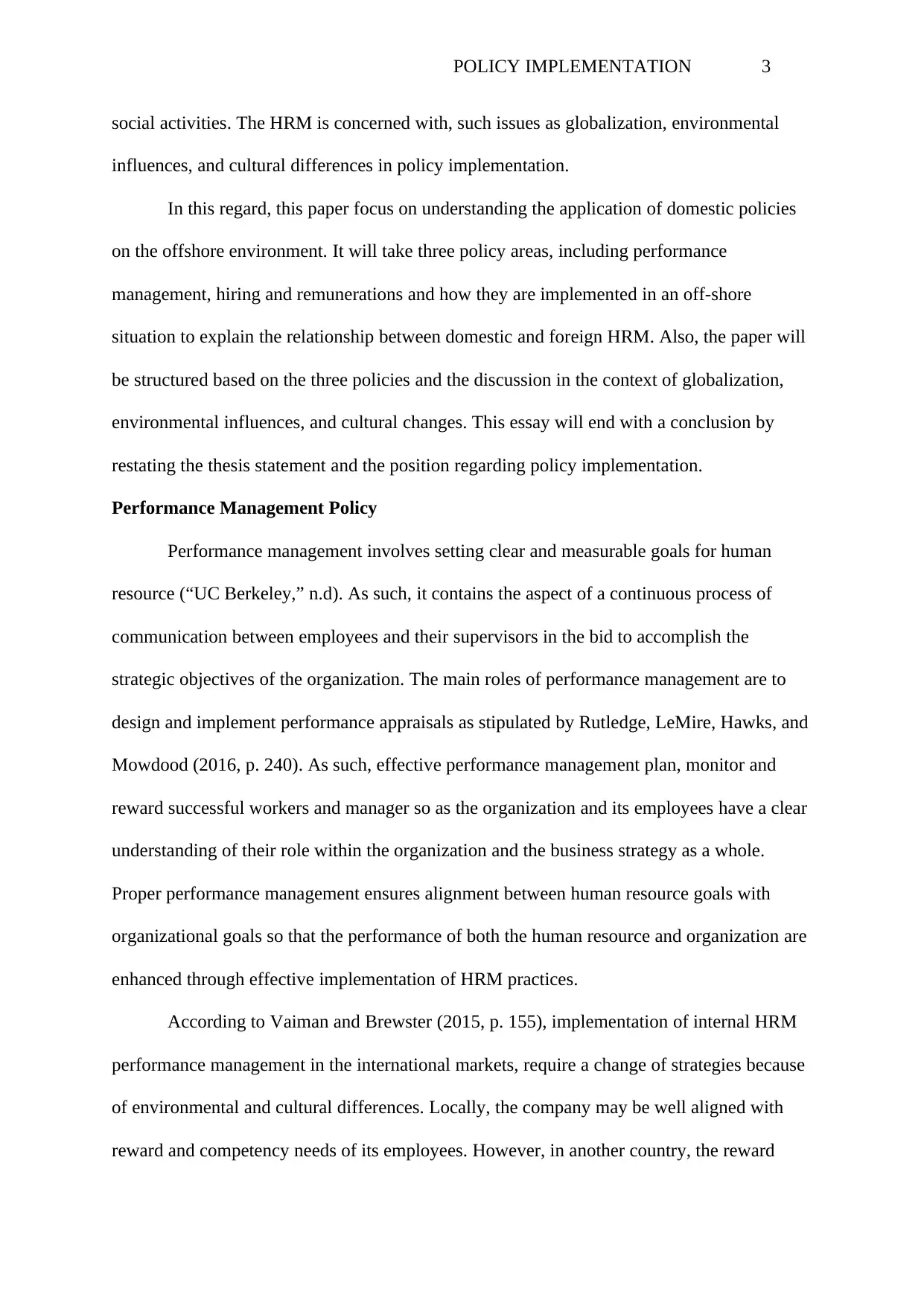
POLICY IMPLEMENTATION 3
social activities. The HRM is concerned with, such issues as globalization, environmental
influences, and cultural differences in policy implementation.
In this regard, this paper focus on understanding the application of domestic policies
on the offshore environment. It will take three policy areas, including performance
management, hiring and remunerations and how they are implemented in an off-shore
situation to explain the relationship between domestic and foreign HRM. Also, the paper will
be structured based on the three policies and the discussion in the context of globalization,
environmental influences, and cultural changes. This essay will end with a conclusion by
restating the thesis statement and the position regarding policy implementation.
Performance Management Policy
Performance management involves setting clear and measurable goals for human
resource (“UC Berkeley,” n.d). As such, it contains the aspect of a continuous process of
communication between employees and their supervisors in the bid to accomplish the
strategic objectives of the organization. The main roles of performance management are to
design and implement performance appraisals as stipulated by Rutledge, LeMire, Hawks, and
Mowdood (2016, p. 240). As such, effective performance management plan, monitor and
reward successful workers and manager so as the organization and its employees have a clear
understanding of their role within the organization and the business strategy as a whole.
Proper performance management ensures alignment between human resource goals with
organizational goals so that the performance of both the human resource and organization are
enhanced through effective implementation of HRM practices.
According to Vaiman and Brewster (2015, p. 155), implementation of internal HRM
performance management in the international markets, require a change of strategies because
of environmental and cultural differences. Locally, the company may be well aligned with
reward and competency needs of its employees. However, in another country, the reward
social activities. The HRM is concerned with, such issues as globalization, environmental
influences, and cultural differences in policy implementation.
In this regard, this paper focus on understanding the application of domestic policies
on the offshore environment. It will take three policy areas, including performance
management, hiring and remunerations and how they are implemented in an off-shore
situation to explain the relationship between domestic and foreign HRM. Also, the paper will
be structured based on the three policies and the discussion in the context of globalization,
environmental influences, and cultural changes. This essay will end with a conclusion by
restating the thesis statement and the position regarding policy implementation.
Performance Management Policy
Performance management involves setting clear and measurable goals for human
resource (“UC Berkeley,” n.d). As such, it contains the aspect of a continuous process of
communication between employees and their supervisors in the bid to accomplish the
strategic objectives of the organization. The main roles of performance management are to
design and implement performance appraisals as stipulated by Rutledge, LeMire, Hawks, and
Mowdood (2016, p. 240). As such, effective performance management plan, monitor and
reward successful workers and manager so as the organization and its employees have a clear
understanding of their role within the organization and the business strategy as a whole.
Proper performance management ensures alignment between human resource goals with
organizational goals so that the performance of both the human resource and organization are
enhanced through effective implementation of HRM practices.
According to Vaiman and Brewster (2015, p. 155), implementation of internal HRM
performance management in the international markets, require a change of strategies because
of environmental and cultural differences. Locally, the company may be well aligned with
reward and competency needs of its employees. However, in another country, the reward
⊘ This is a preview!⊘
Do you want full access?
Subscribe today to unlock all pages.

Trusted by 1+ million students worldwide
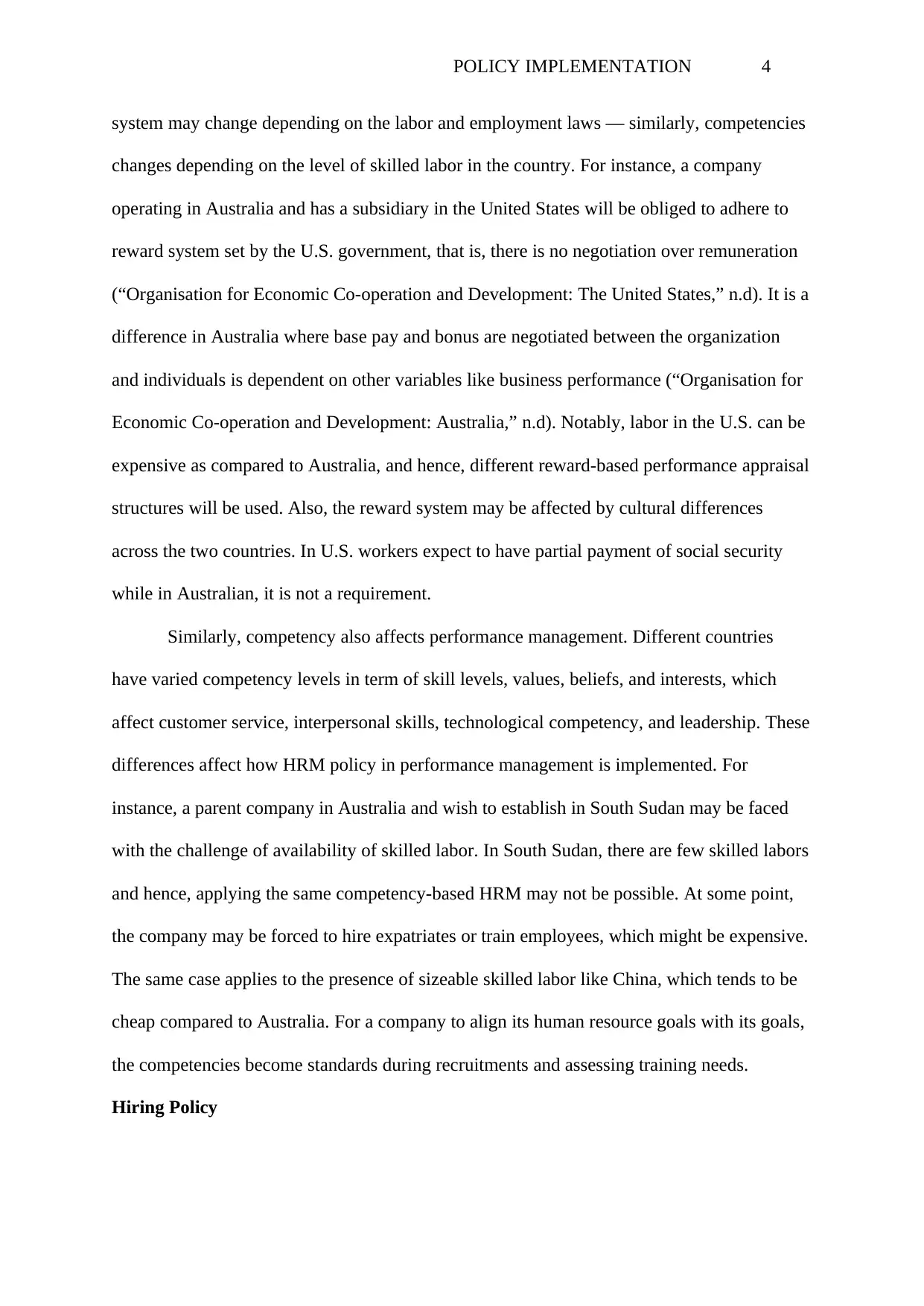
POLICY IMPLEMENTATION 4
system may change depending on the labor and employment laws — similarly, competencies
changes depending on the level of skilled labor in the country. For instance, a company
operating in Australia and has a subsidiary in the United States will be obliged to adhere to
reward system set by the U.S. government, that is, there is no negotiation over remuneration
(“Organisation for Economic Co-operation and Development: The United States,” n.d). It is a
difference in Australia where base pay and bonus are negotiated between the organization
and individuals is dependent on other variables like business performance (“Organisation for
Economic Co-operation and Development: Australia,” n.d). Notably, labor in the U.S. can be
expensive as compared to Australia, and hence, different reward-based performance appraisal
structures will be used. Also, the reward system may be affected by cultural differences
across the two countries. In U.S. workers expect to have partial payment of social security
while in Australian, it is not a requirement.
Similarly, competency also affects performance management. Different countries
have varied competency levels in term of skill levels, values, beliefs, and interests, which
affect customer service, interpersonal skills, technological competency, and leadership. These
differences affect how HRM policy in performance management is implemented. For
instance, a parent company in Australia and wish to establish in South Sudan may be faced
with the challenge of availability of skilled labor. In South Sudan, there are few skilled labors
and hence, applying the same competency-based HRM may not be possible. At some point,
the company may be forced to hire expatriates or train employees, which might be expensive.
The same case applies to the presence of sizeable skilled labor like China, which tends to be
cheap compared to Australia. For a company to align its human resource goals with its goals,
the competencies become standards during recruitments and assessing training needs.
Hiring Policy
system may change depending on the labor and employment laws — similarly, competencies
changes depending on the level of skilled labor in the country. For instance, a company
operating in Australia and has a subsidiary in the United States will be obliged to adhere to
reward system set by the U.S. government, that is, there is no negotiation over remuneration
(“Organisation for Economic Co-operation and Development: The United States,” n.d). It is a
difference in Australia where base pay and bonus are negotiated between the organization
and individuals is dependent on other variables like business performance (“Organisation for
Economic Co-operation and Development: Australia,” n.d). Notably, labor in the U.S. can be
expensive as compared to Australia, and hence, different reward-based performance appraisal
structures will be used. Also, the reward system may be affected by cultural differences
across the two countries. In U.S. workers expect to have partial payment of social security
while in Australian, it is not a requirement.
Similarly, competency also affects performance management. Different countries
have varied competency levels in term of skill levels, values, beliefs, and interests, which
affect customer service, interpersonal skills, technological competency, and leadership. These
differences affect how HRM policy in performance management is implemented. For
instance, a parent company in Australia and wish to establish in South Sudan may be faced
with the challenge of availability of skilled labor. In South Sudan, there are few skilled labors
and hence, applying the same competency-based HRM may not be possible. At some point,
the company may be forced to hire expatriates or train employees, which might be expensive.
The same case applies to the presence of sizeable skilled labor like China, which tends to be
cheap compared to Australia. For a company to align its human resource goals with its goals,
the competencies become standards during recruitments and assessing training needs.
Hiring Policy
Paraphrase This Document
Need a fresh take? Get an instant paraphrase of this document with our AI Paraphraser
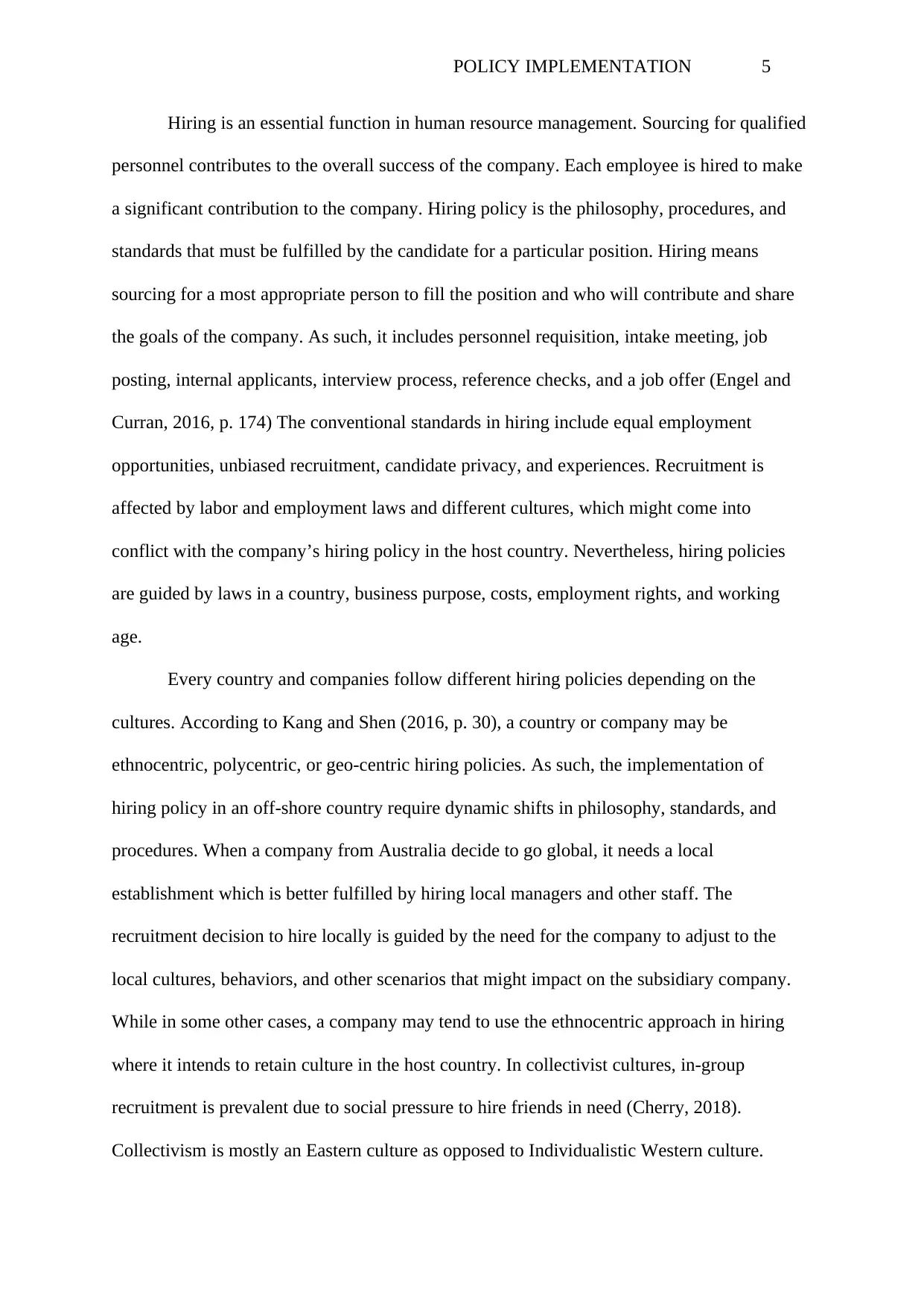
POLICY IMPLEMENTATION 5
Hiring is an essential function in human resource management. Sourcing for qualified
personnel contributes to the overall success of the company. Each employee is hired to make
a significant contribution to the company. Hiring policy is the philosophy, procedures, and
standards that must be fulfilled by the candidate for a particular position. Hiring means
sourcing for a most appropriate person to fill the position and who will contribute and share
the goals of the company. As such, it includes personnel requisition, intake meeting, job
posting, internal applicants, interview process, reference checks, and a job offer (Engel and
Curran, 2016, p. 174) The conventional standards in hiring include equal employment
opportunities, unbiased recruitment, candidate privacy, and experiences. Recruitment is
affected by labor and employment laws and different cultures, which might come into
conflict with the company’s hiring policy in the host country. Nevertheless, hiring policies
are guided by laws in a country, business purpose, costs, employment rights, and working
age.
Every country and companies follow different hiring policies depending on the
cultures. According to Kang and Shen (2016, p. 30), a country or company may be
ethnocentric, polycentric, or geo-centric hiring policies. As such, the implementation of
hiring policy in an off-shore country require dynamic shifts in philosophy, standards, and
procedures. When a company from Australia decide to go global, it needs a local
establishment which is better fulfilled by hiring local managers and other staff. The
recruitment decision to hire locally is guided by the need for the company to adjust to the
local cultures, behaviors, and other scenarios that might impact on the subsidiary company.
While in some other cases, a company may tend to use the ethnocentric approach in hiring
where it intends to retain culture in the host country. In collectivist cultures, in-group
recruitment is prevalent due to social pressure to hire friends in need (Cherry, 2018).
Collectivism is mostly an Eastern culture as opposed to Individualistic Western culture.
Hiring is an essential function in human resource management. Sourcing for qualified
personnel contributes to the overall success of the company. Each employee is hired to make
a significant contribution to the company. Hiring policy is the philosophy, procedures, and
standards that must be fulfilled by the candidate for a particular position. Hiring means
sourcing for a most appropriate person to fill the position and who will contribute and share
the goals of the company. As such, it includes personnel requisition, intake meeting, job
posting, internal applicants, interview process, reference checks, and a job offer (Engel and
Curran, 2016, p. 174) The conventional standards in hiring include equal employment
opportunities, unbiased recruitment, candidate privacy, and experiences. Recruitment is
affected by labor and employment laws and different cultures, which might come into
conflict with the company’s hiring policy in the host country. Nevertheless, hiring policies
are guided by laws in a country, business purpose, costs, employment rights, and working
age.
Every country and companies follow different hiring policies depending on the
cultures. According to Kang and Shen (2016, p. 30), a country or company may be
ethnocentric, polycentric, or geo-centric hiring policies. As such, the implementation of
hiring policy in an off-shore country require dynamic shifts in philosophy, standards, and
procedures. When a company from Australia decide to go global, it needs a local
establishment which is better fulfilled by hiring local managers and other staff. The
recruitment decision to hire locally is guided by the need for the company to adjust to the
local cultures, behaviors, and other scenarios that might impact on the subsidiary company.
While in some other cases, a company may tend to use the ethnocentric approach in hiring
where it intends to retain culture in the host country. In collectivist cultures, in-group
recruitment is prevalent due to social pressure to hire friends in need (Cherry, 2018).
Collectivism is mostly an Eastern culture as opposed to Individualistic Western culture.
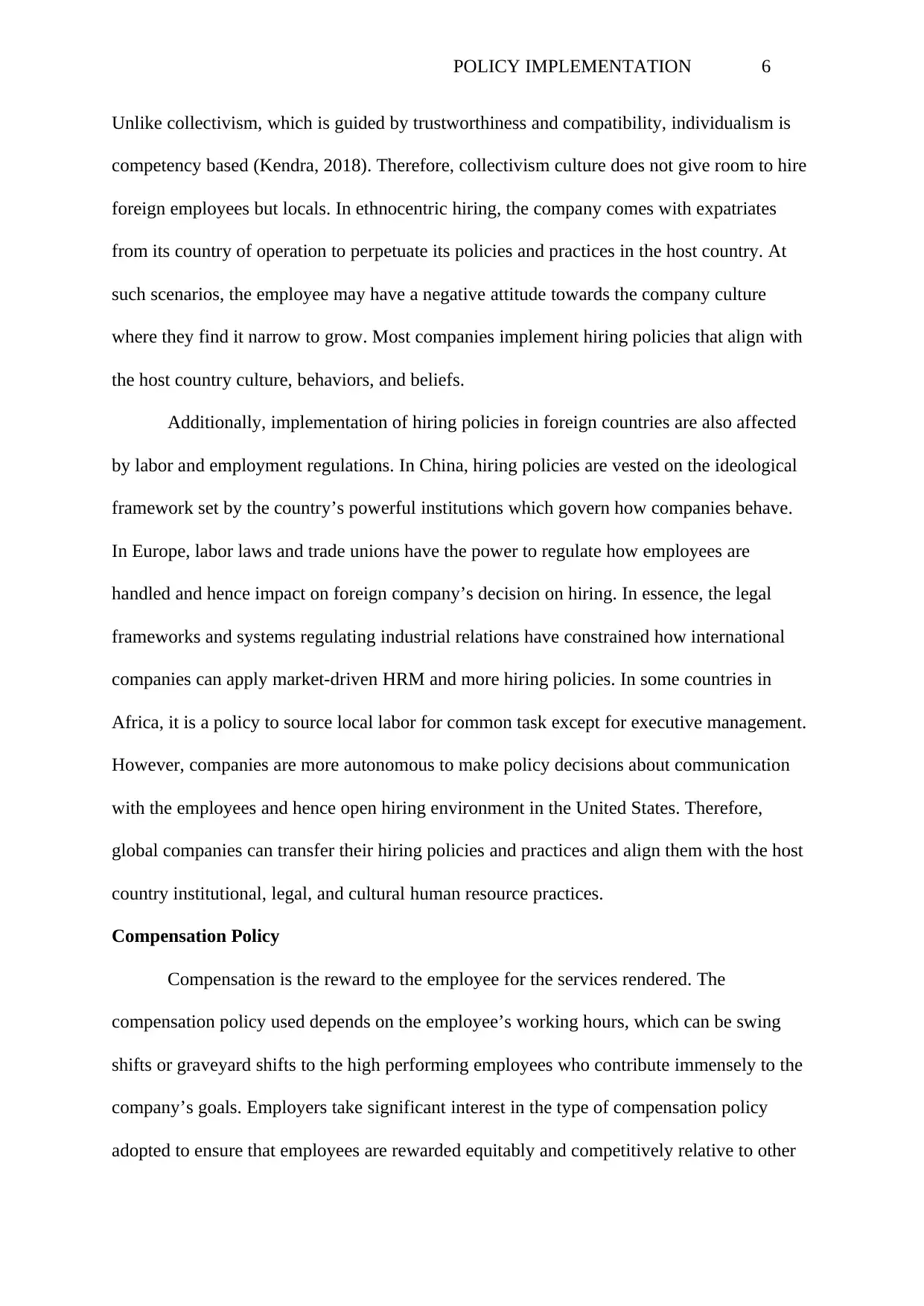
POLICY IMPLEMENTATION 6
Unlike collectivism, which is guided by trustworthiness and compatibility, individualism is
competency based (Kendra, 2018). Therefore, collectivism culture does not give room to hire
foreign employees but locals. In ethnocentric hiring, the company comes with expatriates
from its country of operation to perpetuate its policies and practices in the host country. At
such scenarios, the employee may have a negative attitude towards the company culture
where they find it narrow to grow. Most companies implement hiring policies that align with
the host country culture, behaviors, and beliefs.
Additionally, implementation of hiring policies in foreign countries are also affected
by labor and employment regulations. In China, hiring policies are vested on the ideological
framework set by the country’s powerful institutions which govern how companies behave.
In Europe, labor laws and trade unions have the power to regulate how employees are
handled and hence impact on foreign company’s decision on hiring. In essence, the legal
frameworks and systems regulating industrial relations have constrained how international
companies can apply market-driven HRM and more hiring policies. In some countries in
Africa, it is a policy to source local labor for common task except for executive management.
However, companies are more autonomous to make policy decisions about communication
with the employees and hence open hiring environment in the United States. Therefore,
global companies can transfer their hiring policies and practices and align them with the host
country institutional, legal, and cultural human resource practices.
Compensation Policy
Compensation is the reward to the employee for the services rendered. The
compensation policy used depends on the employee’s working hours, which can be swing
shifts or graveyard shifts to the high performing employees who contribute immensely to the
company’s goals. Employers take significant interest in the type of compensation policy
adopted to ensure that employees are rewarded equitably and competitively relative to other
Unlike collectivism, which is guided by trustworthiness and compatibility, individualism is
competency based (Kendra, 2018). Therefore, collectivism culture does not give room to hire
foreign employees but locals. In ethnocentric hiring, the company comes with expatriates
from its country of operation to perpetuate its policies and practices in the host country. At
such scenarios, the employee may have a negative attitude towards the company culture
where they find it narrow to grow. Most companies implement hiring policies that align with
the host country culture, behaviors, and beliefs.
Additionally, implementation of hiring policies in foreign countries are also affected
by labor and employment regulations. In China, hiring policies are vested on the ideological
framework set by the country’s powerful institutions which govern how companies behave.
In Europe, labor laws and trade unions have the power to regulate how employees are
handled and hence impact on foreign company’s decision on hiring. In essence, the legal
frameworks and systems regulating industrial relations have constrained how international
companies can apply market-driven HRM and more hiring policies. In some countries in
Africa, it is a policy to source local labor for common task except for executive management.
However, companies are more autonomous to make policy decisions about communication
with the employees and hence open hiring environment in the United States. Therefore,
global companies can transfer their hiring policies and practices and align them with the host
country institutional, legal, and cultural human resource practices.
Compensation Policy
Compensation is the reward to the employee for the services rendered. The
compensation policy used depends on the employee’s working hours, which can be swing
shifts or graveyard shifts to the high performing employees who contribute immensely to the
company’s goals. Employers take significant interest in the type of compensation policy
adopted to ensure that employees are rewarded equitably and competitively relative to other
⊘ This is a preview!⊘
Do you want full access?
Subscribe today to unlock all pages.

Trusted by 1+ million students worldwide
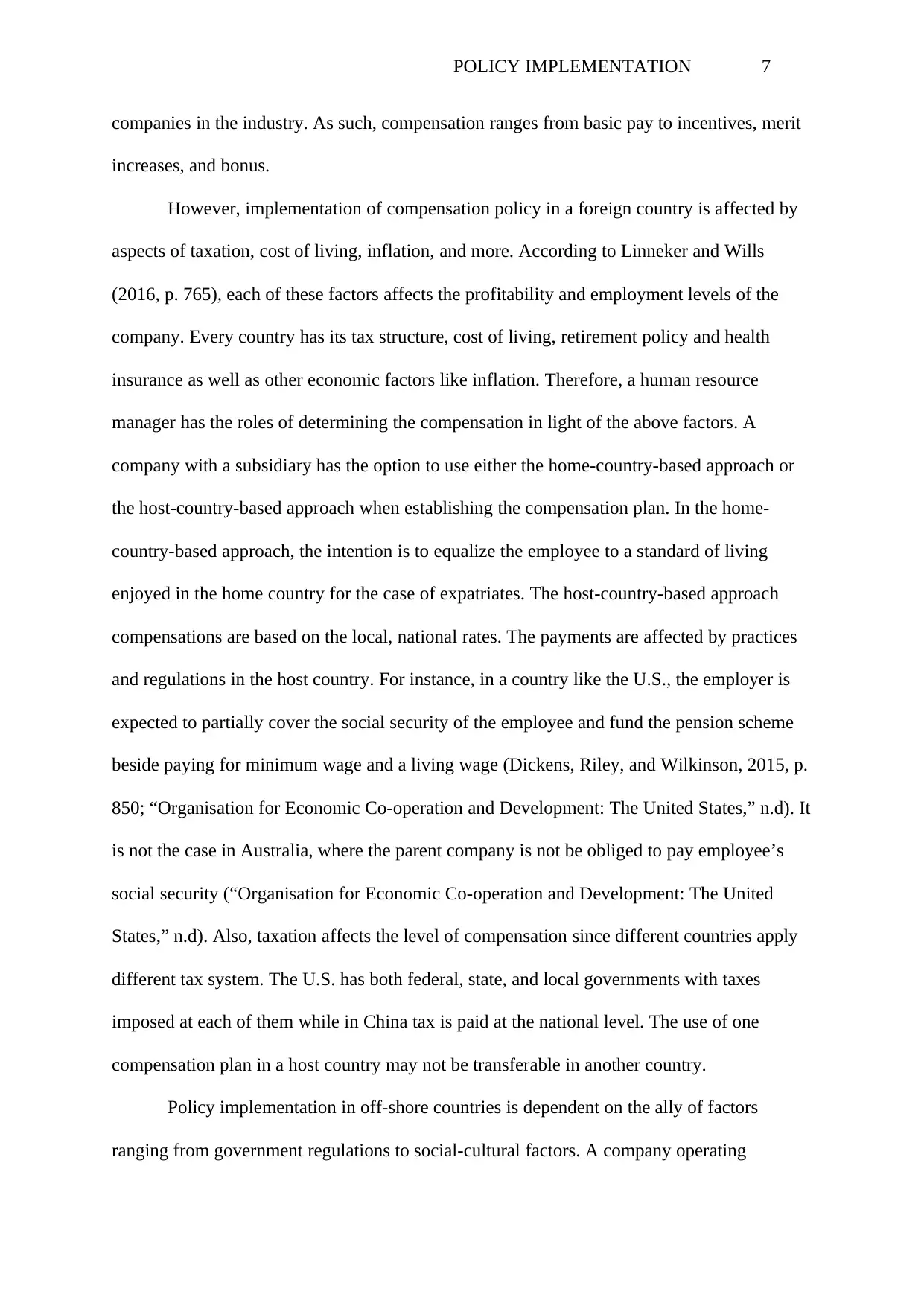
POLICY IMPLEMENTATION 7
companies in the industry. As such, compensation ranges from basic pay to incentives, merit
increases, and bonus.
However, implementation of compensation policy in a foreign country is affected by
aspects of taxation, cost of living, inflation, and more. According to Linneker and Wills
(2016, p. 765), each of these factors affects the profitability and employment levels of the
company. Every country has its tax structure, cost of living, retirement policy and health
insurance as well as other economic factors like inflation. Therefore, a human resource
manager has the roles of determining the compensation in light of the above factors. A
company with a subsidiary has the option to use either the home-country-based approach or
the host-country-based approach when establishing the compensation plan. In the home-
country-based approach, the intention is to equalize the employee to a standard of living
enjoyed in the home country for the case of expatriates. The host-country-based approach
compensations are based on the local, national rates. The payments are affected by practices
and regulations in the host country. For instance, in a country like the U.S., the employer is
expected to partially cover the social security of the employee and fund the pension scheme
beside paying for minimum wage and a living wage (Dickens, Riley, and Wilkinson, 2015, p.
850; “Organisation for Economic Co-operation and Development: The United States,” n.d). It
is not the case in Australia, where the parent company is not be obliged to pay employee’s
social security (“Organisation for Economic Co-operation and Development: The United
States,” n.d). Also, taxation affects the level of compensation since different countries apply
different tax system. The U.S. has both federal, state, and local governments with taxes
imposed at each of them while in China tax is paid at the national level. The use of one
compensation plan in a host country may not be transferable in another country.
Policy implementation in off-shore countries is dependent on the ally of factors
ranging from government regulations to social-cultural factors. A company operating
companies in the industry. As such, compensation ranges from basic pay to incentives, merit
increases, and bonus.
However, implementation of compensation policy in a foreign country is affected by
aspects of taxation, cost of living, inflation, and more. According to Linneker and Wills
(2016, p. 765), each of these factors affects the profitability and employment levels of the
company. Every country has its tax structure, cost of living, retirement policy and health
insurance as well as other economic factors like inflation. Therefore, a human resource
manager has the roles of determining the compensation in light of the above factors. A
company with a subsidiary has the option to use either the home-country-based approach or
the host-country-based approach when establishing the compensation plan. In the home-
country-based approach, the intention is to equalize the employee to a standard of living
enjoyed in the home country for the case of expatriates. The host-country-based approach
compensations are based on the local, national rates. The payments are affected by practices
and regulations in the host country. For instance, in a country like the U.S., the employer is
expected to partially cover the social security of the employee and fund the pension scheme
beside paying for minimum wage and a living wage (Dickens, Riley, and Wilkinson, 2015, p.
850; “Organisation for Economic Co-operation and Development: The United States,” n.d). It
is not the case in Australia, where the parent company is not be obliged to pay employee’s
social security (“Organisation for Economic Co-operation and Development: The United
States,” n.d). Also, taxation affects the level of compensation since different countries apply
different tax system. The U.S. has both federal, state, and local governments with taxes
imposed at each of them while in China tax is paid at the national level. The use of one
compensation plan in a host country may not be transferable in another country.
Policy implementation in off-shore countries is dependent on the ally of factors
ranging from government regulations to social-cultural factors. A company operating
Paraphrase This Document
Need a fresh take? Get an instant paraphrase of this document with our AI Paraphraser
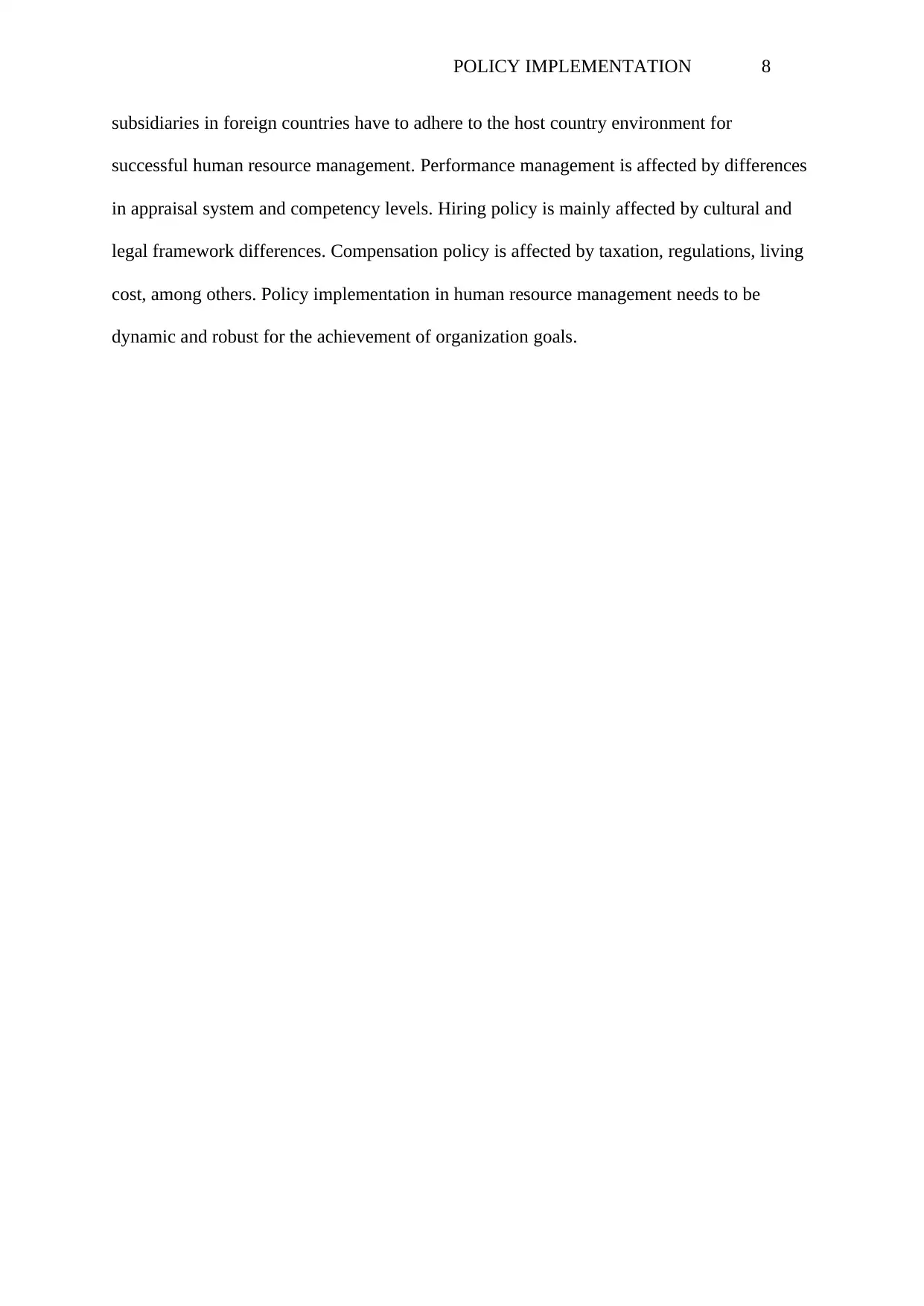
POLICY IMPLEMENTATION 8
subsidiaries in foreign countries have to adhere to the host country environment for
successful human resource management. Performance management is affected by differences
in appraisal system and competency levels. Hiring policy is mainly affected by cultural and
legal framework differences. Compensation policy is affected by taxation, regulations, living
cost, among others. Policy implementation in human resource management needs to be
dynamic and robust for the achievement of organization goals.
subsidiaries in foreign countries have to adhere to the host country environment for
successful human resource management. Performance management is affected by differences
in appraisal system and competency levels. Hiring policy is mainly affected by cultural and
legal framework differences. Compensation policy is affected by taxation, regulations, living
cost, among others. Policy implementation in human resource management needs to be
dynamic and robust for the achievement of organization goals.
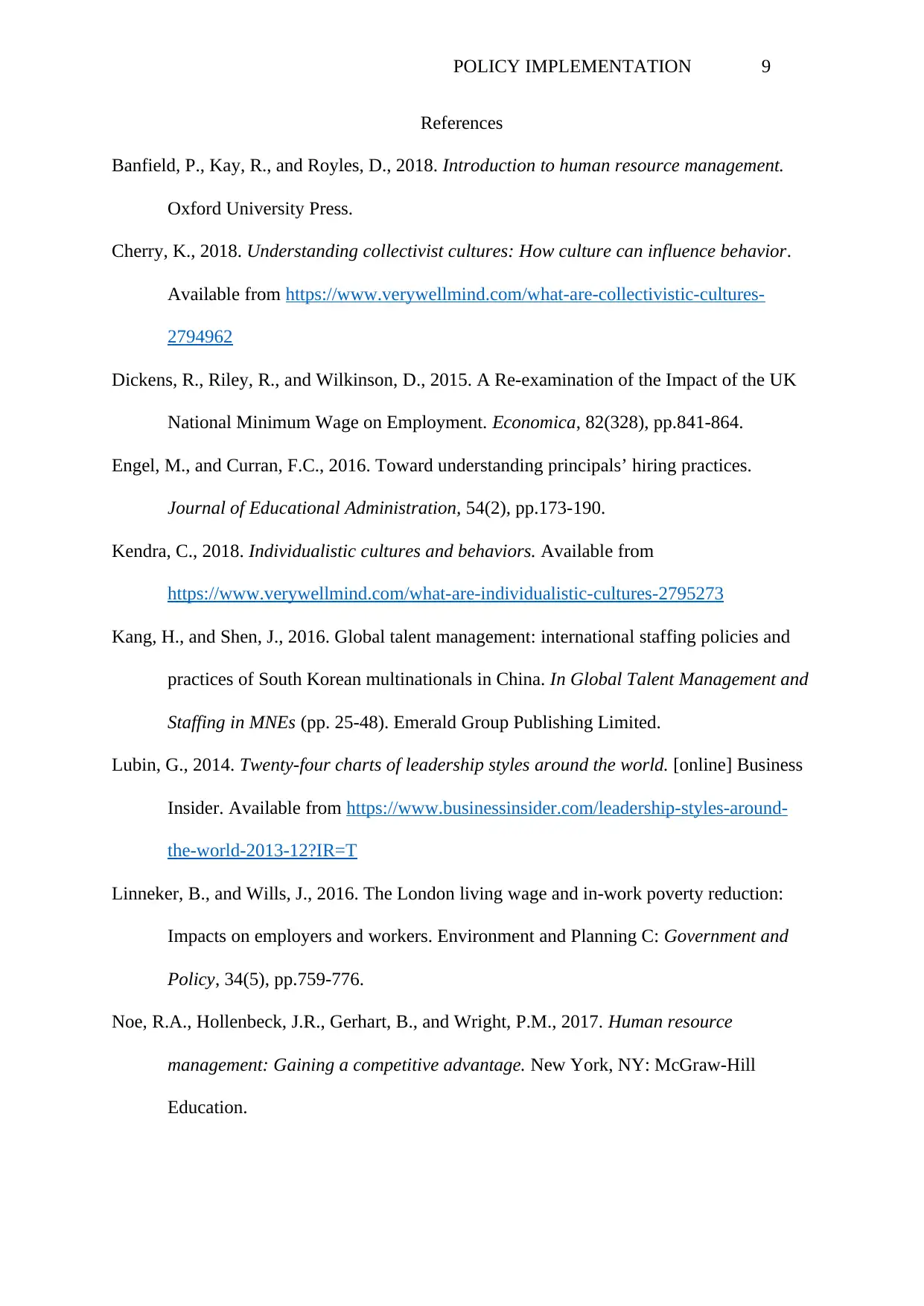
POLICY IMPLEMENTATION 9
References
Banfield, P., Kay, R., and Royles, D., 2018. Introduction to human resource management.
Oxford University Press.
Cherry, K., 2018. Understanding collectivist cultures: How culture can influence behavior.
Available from https://www.verywellmind.com/what-are-collectivistic-cultures-
2794962
Dickens, R., Riley, R., and Wilkinson, D., 2015. A Re‐examination of the Impact of the UK
National Minimum Wage on Employment. Economica, 82(328), pp.841-864.
Engel, M., and Curran, F.C., 2016. Toward understanding principals’ hiring practices.
Journal of Educational Administration, 54(2), pp.173-190.
Kendra, C., 2018. Individualistic cultures and behaviors. Available from
https://www.verywellmind.com/what-are-individualistic-cultures-2795273
Kang, H., and Shen, J., 2016. Global talent management: international staffing policies and
practices of South Korean multinationals in China. In Global Talent Management and
Staffing in MNEs (pp. 25-48). Emerald Group Publishing Limited.
Lubin, G., 2014. Twenty-four charts of leadership styles around the world. [online] Business
Insider. Available from https://www.businessinsider.com/leadership-styles-around-
the-world-2013-12?IR=T
Linneker, B., and Wills, J., 2016. The London living wage and in-work poverty reduction:
Impacts on employers and workers. Environment and Planning C: Government and
Policy, 34(5), pp.759-776.
Noe, R.A., Hollenbeck, J.R., Gerhart, B., and Wright, P.M., 2017. Human resource
management: Gaining a competitive advantage. New York, NY: McGraw-Hill
Education.
References
Banfield, P., Kay, R., and Royles, D., 2018. Introduction to human resource management.
Oxford University Press.
Cherry, K., 2018. Understanding collectivist cultures: How culture can influence behavior.
Available from https://www.verywellmind.com/what-are-collectivistic-cultures-
2794962
Dickens, R., Riley, R., and Wilkinson, D., 2015. A Re‐examination of the Impact of the UK
National Minimum Wage on Employment. Economica, 82(328), pp.841-864.
Engel, M., and Curran, F.C., 2016. Toward understanding principals’ hiring practices.
Journal of Educational Administration, 54(2), pp.173-190.
Kendra, C., 2018. Individualistic cultures and behaviors. Available from
https://www.verywellmind.com/what-are-individualistic-cultures-2795273
Kang, H., and Shen, J., 2016. Global talent management: international staffing policies and
practices of South Korean multinationals in China. In Global Talent Management and
Staffing in MNEs (pp. 25-48). Emerald Group Publishing Limited.
Lubin, G., 2014. Twenty-four charts of leadership styles around the world. [online] Business
Insider. Available from https://www.businessinsider.com/leadership-styles-around-
the-world-2013-12?IR=T
Linneker, B., and Wills, J., 2016. The London living wage and in-work poverty reduction:
Impacts on employers and workers. Environment and Planning C: Government and
Policy, 34(5), pp.759-776.
Noe, R.A., Hollenbeck, J.R., Gerhart, B., and Wright, P.M., 2017. Human resource
management: Gaining a competitive advantage. New York, NY: McGraw-Hill
Education.
⊘ This is a preview!⊘
Do you want full access?
Subscribe today to unlock all pages.

Trusted by 1+ million students worldwide
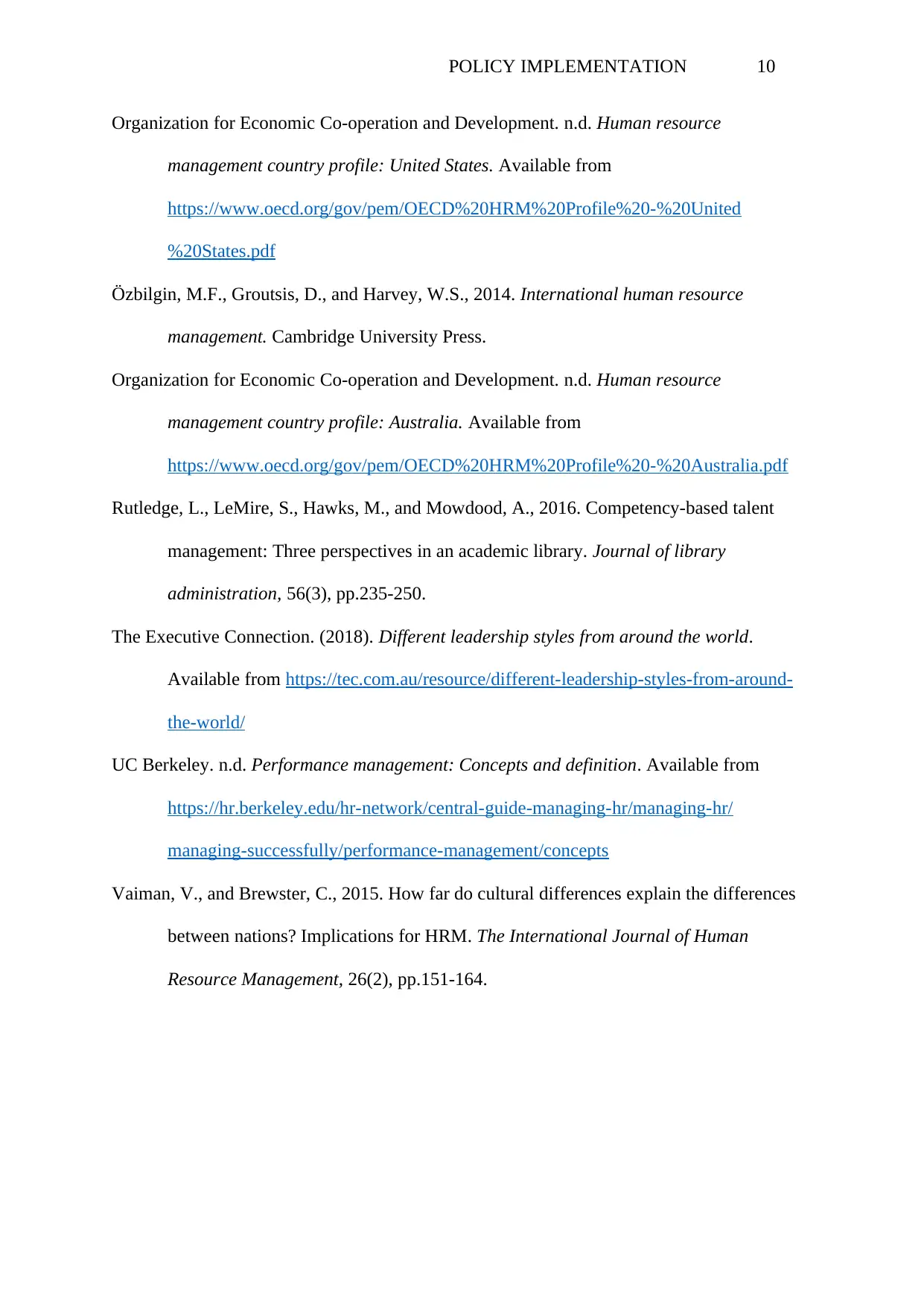
POLICY IMPLEMENTATION 10
Organization for Economic Co-operation and Development. n.d. Human resource
management country profile: United States. Available from
https://www.oecd.org/gov/pem/OECD%20HRM%20Profile%20-%20United
%20States.pdf
Özbilgin, M.F., Groutsis, D., and Harvey, W.S., 2014. International human resource
management. Cambridge University Press.
Organization for Economic Co-operation and Development. n.d. Human resource
management country profile: Australia. Available from
https://www.oecd.org/gov/pem/OECD%20HRM%20Profile%20-%20Australia.pdf
Rutledge, L., LeMire, S., Hawks, M., and Mowdood, A., 2016. Competency-based talent
management: Three perspectives in an academic library. Journal of library
administration, 56(3), pp.235-250.
The Executive Connection. (2018). Different leadership styles from around the world.
Available from https://tec.com.au/resource/different-leadership-styles-from-around-
the-world/
UC Berkeley. n.d. Performance management: Concepts and definition. Available from
https://hr.berkeley.edu/hr-network/central-guide-managing-hr/managing-hr/
managing-successfully/performance-management/concepts
Vaiman, V., and Brewster, C., 2015. How far do cultural differences explain the differences
between nations? Implications for HRM. The International Journal of Human
Resource Management, 26(2), pp.151-164.
Organization for Economic Co-operation and Development. n.d. Human resource
management country profile: United States. Available from
https://www.oecd.org/gov/pem/OECD%20HRM%20Profile%20-%20United
%20States.pdf
Özbilgin, M.F., Groutsis, D., and Harvey, W.S., 2014. International human resource
management. Cambridge University Press.
Organization for Economic Co-operation and Development. n.d. Human resource
management country profile: Australia. Available from
https://www.oecd.org/gov/pem/OECD%20HRM%20Profile%20-%20Australia.pdf
Rutledge, L., LeMire, S., Hawks, M., and Mowdood, A., 2016. Competency-based talent
management: Three perspectives in an academic library. Journal of library
administration, 56(3), pp.235-250.
The Executive Connection. (2018). Different leadership styles from around the world.
Available from https://tec.com.au/resource/different-leadership-styles-from-around-
the-world/
UC Berkeley. n.d. Performance management: Concepts and definition. Available from
https://hr.berkeley.edu/hr-network/central-guide-managing-hr/managing-hr/
managing-successfully/performance-management/concepts
Vaiman, V., and Brewster, C., 2015. How far do cultural differences explain the differences
between nations? Implications for HRM. The International Journal of Human
Resource Management, 26(2), pp.151-164.
1 out of 10
Related Documents
Your All-in-One AI-Powered Toolkit for Academic Success.
+13062052269
info@desklib.com
Available 24*7 on WhatsApp / Email
![[object Object]](/_next/static/media/star-bottom.7253800d.svg)
Unlock your academic potential
Copyright © 2020–2025 A2Z Services. All Rights Reserved. Developed and managed by ZUCOL.




